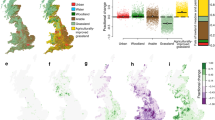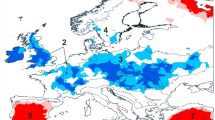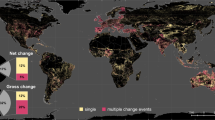Abstract
High rates of climate and land-use changes threaten biodiversity and ecosystem function1,2, creating a need for integrated assessments and planning at regional to global scales. We develop a new approach to measure multivariate estimates of climate and land-use change that builds on recently developed measures of climate velocity3,4,5,6, and apply it to assess the combined speeds of climate and land use for the conterminous US from 2001 to 2051. The combined speeds of climate and land-use change are highest in a broad north-to-south swath in the central US and in parts of the intermountain west. Climate speeds are roughly an order of magnitude higher than land-use speeds in most regions, but land-use speed is particularly high in the Appalachians and north-central forests. Joint speeds are low across much of the intermountain west. Our results highlight areas expected to be most vulnerable to changes in biodiversity and ecosystem function due to the individual or combined effects of climate and land-use change. The integration of climate and land-use scenarios suggests different conservation prioritization strategies from climate velocities and species alone7.
This is a preview of subscription content, access via your institution
Access options
Subscribe to this journal
Receive 12 print issues and online access
$209.00 per year
only $17.42 per issue
Buy this article
- Purchase on Springer Link
- Instant access to full article PDF
Prices may be subject to local taxes which are calculated during checkout



Similar content being viewed by others
References
Chapin, F. S. III et al. Consequences of changing biodiversity. Nature 405, 234–242 (2000).
Dawson, T. P., Jackson, S. T., House, J. I., Prentice, I. C. & Mace, G. M. Beyond predictions: Biodiversity conservation in a changing climate. Science 332, 53–58 (2011).
Loarie, S. R. et al. The velocity of climate change. Nature 462, 1052–1055 (2009).
Burrows, M. T. et al. The pace of shifting climate in marine and terrestrial ecosystems. Science 334, 652–655 (2011).
Dobrowski, S. Z. et al. The climate velocity of the contiguous United States during the 20th century. Glob. Change Biol. 19, 241–251 (2013).
Ordonez, A. & Williams, J. Projected climate reshuffling based on multivariate climate-availability, climate-analog, and climate-velocity analyses: Implications for community disaggregation. Climatic Change 119, 659–675 (2013).
Tingley, M. W., Estes, L. D. & Wilcove, D. S. Ecosystems: Climate change must not blow conservation off course. Nature 500, 271–272 (2013).
Williams, J. W., Jackson, S. T. & Kutzbach, J. E. Projected distributions of novel and disappearing climates by 2100 AD. Proc. Natl Acad. Sci. USA 104, 5738–5742 (2007).
Ohlemüller, R., Gritti, E. S., Sykes, M. T. & Thomas, C. D. Towards European climate risk surfaces: The extent and distribution of analogous and non-analogous climates 1931–2100. Glob. Ecol. Biogeography 15, 395–405 (2006).
Martinuzzi, S. et al. Key areas for conserving United States’ biodiversity likely threatened by future land use change. Ecosphere 4, art58 (2013).
Radeloff, V. et al. Economic-based projections of future land use in the conterminous United States under alternative policy scenarios. Ecol. Appl. 22, 1036–1049 (2012).
Lawler, J. J. et al. Projected land-use change impacts on ecosystem services in the United States. Proc. Natl Acad. Sci. USA 111, 7492–7497 (2014).
IPCC, Climate Change 2013: The Physical Science Basis (Cambridge Univ. Press, 2013).
Ordonez, A. & Williams, J. W. Climatic and biotic velocities for woody taxa distributions over the last 16 000 years in eastern North America. Ecol. Lett. 16, 773–781 (2013).
Svenning, J-C. & Sandel, B. Disequilibrium vegetation dynamics under future climate change. Am. J. Bot. 100, 1266–1286 (2013).
Devictor, V. et al. Differences in the climatic debts of birds and butterflies at a continental scale. Nature Clim. Change 2, 121–124 (2012).
Sandel, B. et al. The influence of late quaternary climate-change velocity on species endemism. Science 334, 660–664 (2011).
Dullinger, S. et al. Europe’s other debt crisis caused by the long legacy of future extinctions. Proc. Natl Acad. Sci. USA 110, 7342–7347 (2013).
Parmesan, C. & Yohe, G. A globally coherent fingerprint of climate change impacts across natural systems. Nature 421, 37–42 (2003).
Chen, I. C., Hill, J. K., Ohlemüller, R., Roy, D. B. & Thomas, C. D. Rapid range shifts of species associated with high levels of climate warming. Science 333, 1024–1026 (2011).
Jetz, W., Wilcove, D. S. & Dobson, A. P. Projected impacts of climate and land-use change on the global diversity of birds. PLoS Biol. 5, 1211–1219 (2007).
Bomhard, B. et al. Potential impacts of future land use and climate change on the red list status of the proteaceae in the cape floristic region, South Africa. Glob. Change Biol. 11, 1452–1468 (2005).
Thuiller, W., Lavorel, S., Sykes, M. T. & Araujo, M. B. Using niche-based modelling to assess the impact of climate change on tree functional diversity in Europe. Divers. Distrib. 12, 49–60 (2006).
Williams, J. W., Shuman, B. N., Webb, T., Bartlein, P. J. & Leduc, P. L. Late-quaternary vegetation dynamics in North America: Scaling from taxa to biomes. Ecol. Monograph 74, 309–334 (2004).
Millar, C. I., Stephenson, N. L. & Stephens, S. L. Climate change and forests of the future: Managing in the face of uncertainty. Ecol. Appl. 17, 2145–2151 (2007).
Brook, B. W., Sodhi, N. S. & Bradshaw, C. J. A. Synergies among extinction drivers under global change. Trends Ecol. Evol. 23, 453–460 (2008).
Hoegh-Guldberg, O. et al. Assisted colonization and rapid climate change. Science 321, 345–346 (2008).
Bottrill, M. C. et al. Is conservation triage just smart decision making? Trends Ecol. Evol. 23, 649–654 (2008).
Watson, J. E. M., Iwamura, T. & Butt, N. Mapping vulnerability and conservation adaptation strategies under climate change. Nature Clim. Change 3, 989–994 (2013).
Brekke, L., Thrasher, B., Maurer, E. P. & Pruitt, T. Downscaled CMIP3 and CMIP5 Climate Projections: Release of Downscaled CMIP5 Climate Projections, Comparison with Preceding Information, and Summary of User Needs (US Dept of Interior, Bureau of Reclamation, 2013).
Acknowledgements
The authors would like to thank S. Veloz, G. Schuurman, S. Stewart and L. Estes for their helpful comments and suggestions, which improved this manuscript. We gratefully acknowledge the financial support for this research by the Bryson Climate, People and Environment Program, the HISTFUNC project (ERC Starting Grant 310886), NSF DEB-1257508, NSF’s Coupled Natural and Human Systems Program, and NASA’s Land Cover and Land Use Change Program.
Author information
Authors and Affiliations
Contributions
A.O. and J.W.W. developed the multivariate metric, A.O. downscaled the climatic data, ran analyses, and produced figures and tables. S.M. and V.C.R. produced the land-use-change model scenarios. A.O. led the writing, with the assistance of J.W.W., S.M. and V.C.R. All authors contributed equally to development and discussion of ideas.
Corresponding author
Ethics declarations
Competing interests
The authors declare no competing financial interests.
Supplementary information
Rights and permissions
About this article
Cite this article
Ordonez, A., Martinuzzi, S., Radeloff, V. et al. Combined speeds of climate and land-use change of the conterminous US until 2050. Nature Clim Change 4, 811–816 (2014). https://doi.org/10.1038/nclimate2337
Received:
Accepted:
Published:
Issue Date:
DOI: https://doi.org/10.1038/nclimate2337
This article is cited by
-
Predicting distribution and range dynamics of Trillium govanianum under climate change and growing human footprint for targeted conservation
Plant Ecology (2022)
-
Climate and land-use changes reduce the benefits of terrestrial protected areas
Nature Climate Change (2021)
-
Fine-grained climate velocities reveal vulnerability of protected areas to climate change
Scientific Reports (2020)
-
Landscape Connectivity Planning for Adaptation to Future Climate and Land-Use Change
Current Landscape Ecology Reports (2019)
-
Habitat-based conservation strategies cannot compensate for climate-change-induced range loss
Nature Climate Change (2017)



